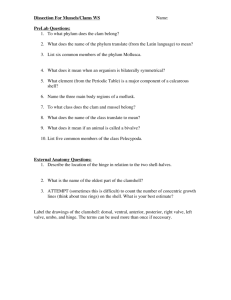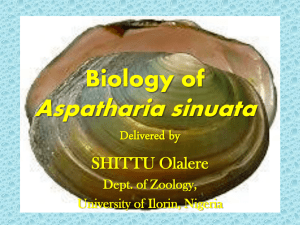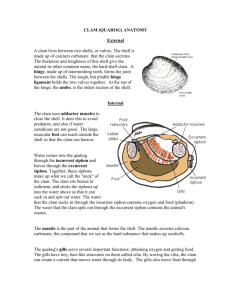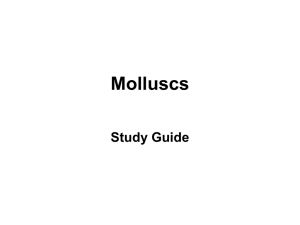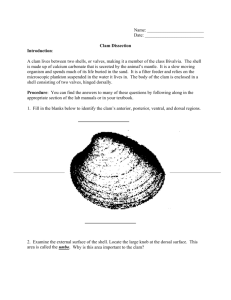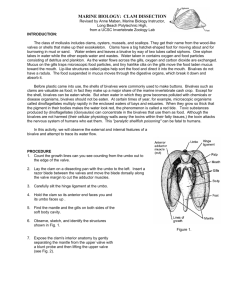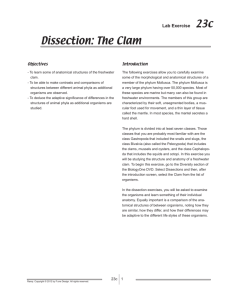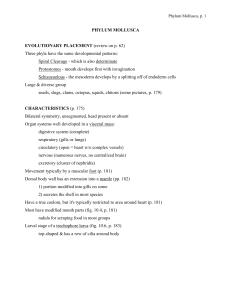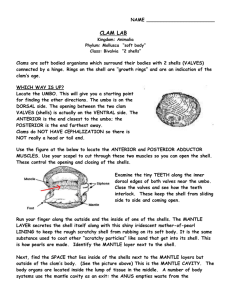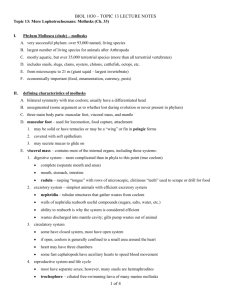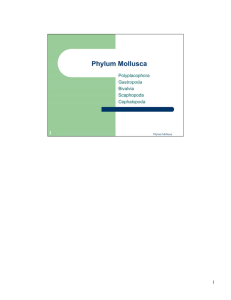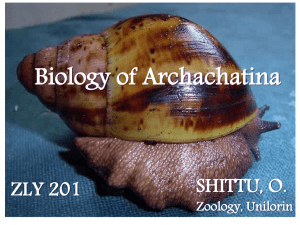Dissection Guide for the Clam (Mussel)
advertisement
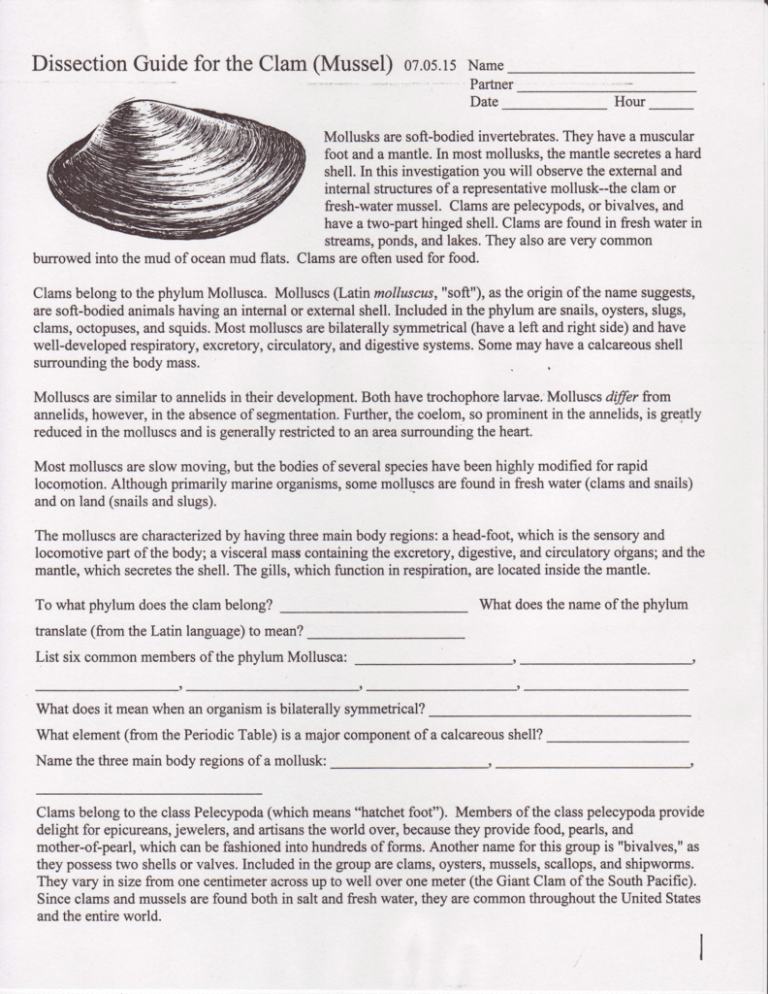
Name
Dissection Guide for the Clam (Mussel) 07.0s.15
Partner
Date
Hour
Theyhavea muscular
Mollusksaresoft-bodiedinvertebrates.
a hard
foot anda mantle.In mostmollusks,the mantlesecretes
you
external
and
shell.In this investigation will observethe
mollusk--theclamor
internalstructuresof a representative
pelecypods,
are
or bivalves,and
fresh-watermussel.Clams
havea two-parthingedshell.Clamsarefoundin freshwaterin
streams,ponds,andlakes.Theyalsoarevery common
burrowedinto the mud of oceanmud flats. Clamsareoftenusedfor food.
Clamsbelongto thephylumMollusca. Molluscs(Latin molluscus,"soft"), asthe origin of the namesuggests,
aresoft-bodiedanimalshavingan internalor externalshell.Includedin the phylumaresnails,oysters,slugs,
clams,octopuses,
andsquids.Most molluscsarebilaterallysymmetrical(havea left andright side)andhave
shell
well-developedrespiratory,excretory,circulatory,anddigestivesystems.Somemay havea calcareous
surroundingthe bodymass.
Molluscsaresimilarto annelidsin their development.
Both havetrochophorelarvae.Molluscsdiffer from
annelids,however,in the absence
of segmentation.
Further,the coelom,soprominentin the annelids,is greatly
generally
reducedin the molluscsandis
restrictedto an areasurroundingthe heart.
Most molluscsareslow moving,but the bodiesof severalspecieshavebeenhighly modifiedfor rapid
locomotion.Althoughprimarily marineorganisms,somemolluscsarefoundin freshwater(clamsandsnails)
andon land(snailsandslugs).
The molluscsarecharacterized
by havingthreemainbodyregions:a head-foot,which is the sensoryand
locomotivepart of thebody; a visceralmaFscontainingthe excretory,digestive,andcirculatoryofgans;andthe
mantle,which secretes
the shell.The gills, which functionin respiration,arelocatedinsidethe mantle.
To what phylumdoesthe clambelong?
Whatdoesthe nameof the phylum
translate(from the Latin language)to mean?
List six commonmembersof thephylumMollusca:
Whatdoesit meanwhenan organismis bilaterallysymmetrical?
shell?
Whatelement(from the PeriodicTable)is a majorcomponentof a calcareous
Namethe threemainbodyregionsof a mollusk:
(whichmeans"hatchetfoot"). Membersof the classpelecypodaprovide
Clamsbelongto the classPelecypoda
jewelers,
delightfor epicureans,
andartisanstheworld over,becausetheyprovidefood,pearls,and
mother-of-pearl,
which canbe fashionedinto hundredsof forms.Anothernamefor this groupis "bivalves,"as
they possess
two shellsor valves.Includedin the Soup areclams,oysters,mussels,scallops,andshipworms.
They vary in sizefrom onecentimeteracrossup to well overonemeter(theGiantClamof the SouthPacific).
Sinceclamsandmusselsarefoundboth in saltandfreshwater,they arecommonthroughouttheUnitedStates
andthe entireworld.
To what class doesthe clam belons?
the Latin language)to mean? --
What doesthe name of the classtranslate(from
What does it mean if an animal is called a bivalve?
An epicureanwould be interestedin
List five common membersof the classPelecypoda:
External Anatomyof the Clam
Obtaina preservedclamandrinseit thoroughlyto removeexcesspreservative.
Placethe clamin a dissecting
tray.
Observethe bivalveshell.Noticethehingeligament The
small,pointedareanearthe hingeligamentis calledthe
umbo.It is the oldestpan of the chin.The umbois situated
dorsallytowardthe anteriorendof the clamandis surrounded
by concentricgrowthlines.The linesrepresentalternating
periodsof slow andrapidgrowth.
/4//ll
Z)2,.t
=,/l
>z
Beforeyou continuewith this investigation,it is importantto
know the orientationof the clamshell.Recallthattheumbois neartheanteriorend.Theposteriorof the clam
shellis at the oppositeend.In referenceto the clamshell,dorsalis the side,or edge,with theumbo.Ventralis
the side,or edge,oppositetheumbo.Locatethe posterior,anterior,dorsal,andventralsurfacesof your clam
shell.Hold the clamshellwith the anteriorendup andthe hingefacingtowardyou. Locatetheposterior,right
valve,andleft valveof theclamshell.
Describethe locationof the hingein relationto the two shell-halves.
Whatis the nameof the oldestpart of the clamshell?
ATTEMPT (sometimes
this is difficult) to countthe numberof concentricgrowthlines(think abouttreerings)
on the shell. What is vour bestestimate?
On the following drawingsof the clamshell,labelthe following: dorsal,ventral,anterior,posterior,right valve,
left valve,andhinge. Thetermscanbe usedmorethanonceif necessary.
Tagthe following: (Note:
Do not try to pin the shell.
Makeyour tagsand"stick"
themto the partswith
moisturefrom the shell.)
Dorsal
Ventral
Anterior
Posterior
Right valve
Left valve
Umbo
Verified
Hold the clam in the dissectingtray as shown in the figure at
the right. With a scalpelcarefully scrape,away some of the
horny outer layer of the shell. Scrapeuntil you seethe "white
part" (prismatic layer) of the shell-it doesnot needto be a
very large area. CAUTION: Scrape in a direction away
from your hand to avoid cutting yourself.
Completed
The shellof a clamis madeup of threelayers:the homy outer
layer,the thick, middlelayercalledthe prismaticlayer,and
the innermostlayercalledthe pearlylayer. Haveyour
instructorplaceonedropof acidon the exposedprismatic
layer.CAUTION: Do not let any acid contactyour skin to
avoid acid burns. The bubblingof the acidindicatesthat
calciumcarbonate(CaCOl)ispresent.Carefullyrinsethe
shellwith wateronceyou havemadeyour observations.
Flg. '$'2
Describewhat happenedwhen acid was placed on the exposedprismatic layer:
Describea situationwherewhatyou observedmight actuallybe appliedto the clamin its naturalenvironment:
Give the chemical
Name the material (chemical) that makesup the clam shell:
formula of the material:
Here is some extra information on the make-up of the clam shtill:
How many layers make up the "shell"
of the clam?
How manylayersmakeup the
"mantle"of the clam?
Which part of the clamshellforms
Periostracum
pearls?
layer
Prismatic
Shell
Nacr€ouslayer
(
'ir.,.,i ir.*'-'
,,i....,lti i.",
^\/.- ;'i; .
Foreignbody (sand or a Parasite)
belweenshell and mantle
-
Nacre-secretingcells
.-
Conneclivetissue
betweenthe shell and mantle.
white part of the clam shell (you
I uantre The
applied the acid to in the exercise
I
I
C i l i a t e de p i t h e l i u m
Pearl lormed bY secretion
o{ nacre around loreign bodY
A pearlis formedasa reactionto a
I
)
above) is the
Epitheliumis betterknownasby its
commonname:
**Put on a pair of safetyglassesduring the processof opening
the muSsel.
Internal Anatomyof the Clam:
Your clamshouldbe slightly gappedopen. Theremight evenbe a pieceof woodwedgedbetweenthe valvesthis guarantees
getsinsidethe shellhalves.
thepreservative
Gills
Try first to pry it openwith your hands.If this will not work, usea
screwdriverto very gentlypry the valvesapart. Your clamshould
look like the oneshownto the right.
Look at thepartiallyopenedshell.Observethe anterioradductor
muscle,posterioradductormuscle,mantle,andfoot. The opening
betweenthetwo shellsis calledthe gape.Carefullyinsertthe
scalpelbetweenthe mantleandthe left valveof the shell.Cut the
anterioradductormuscleascloseto the shellaspossible.
CAUTION: The scalpelis a sharp instrument.Alwaysbe very
carefulwhen handlingit and cut awayfrom your hand and
body.
Repeatthis procedureto cut the posterioradduitor
muscle.Openthe shell.If necessary,
carefullyrun
your fingersor scalpelbetweenthe shellandthe
mantleto separate
the mantlefrom the shell.The
LINE OF OROWIH
R ADDUCIOI
gts ferio
r
ADDUCTORMUSCLE
il;;:fa'
spbcebetweenthe two halves of the mantle is the
mantlecaviw.
sCAI.^PET
SLADE
Openthe left valveasfar aspossible.Whendone,
your specimenshouldlook like the diagrambelow.
M a n t l el i n e
Anltrior'
a d d u c t o rs c a r
Completed(thetwo shellhalvesareopenasshownto theright).
Verified
Observethehinge.Noticethe interlockingteeththat hold the
two valvesof the shelltogether.Locatethe "scars"from the
anteriorandposterioradductormuscleson the innersurfaceof
the left valve.Thesescarsindicatewheretheposteriorand
anterioradductormuscleswereattached.
What is the gape?
What formsthe "scars"on the valves?
Describe the inner layer of the shell.
hjeril.
r adductor muscle
.l
Lets stop for just a moment on this page and look at some of the living clam's anatomy. The diagramsbelow
show how he looks when healthy and alive. The foot and siphonsare extended. Yours will not-look exactly
like this becauseit is deadand theseappendageshave beenretractedinto the shell.
UMSO
VALVE(SHELL)
Herearesometermsyou will needto becomefamiliarwith to continuewith the dissection.Spenda few minute
studyingthem-it will help!
Stnrcture
Anterioradductormuscle
Posterioradductormuscle
Mantle
Description/l,ocation
Anterioredgeinsideshell
Posterioredseinsideshell
Membranous
tissuethatcovers
entirebody;yellowor cream-
Function
Holdstwo halvesof shelltogether
Holdstwo halvesof shelltosether
Secretes
shell
eolored
Foot
Gills
hcurrent srpnon
Fxcurrentsiphon
Palps
Mouth
Stomach
Intestine
Digestivegland(liver)
Anus
Reproductiveorgan
Pericardialcavity
Heart
Kidneys
Hatchet-shaped;
hard;anteriorand
ventralto sills
Folded,ridgedtissuewith microscopiccilia
t old ln mantle;posteriorendventral to excunentsiohon
Foldin mantle;posteriorend;dorsalto incurrentsiphon
leatlike structuresanteriorto gills
and posteriorto anterioradductor
muscle
Slit betweenpalps
Saclikestructurenearmouth
Coiledtubulefrom stomach
throushbodvto anus
Light greenmasssurrounding
stomach
End of intestinenearexcunent
siohon
Spong reddishmassventralto
oalos
fuea betweenvisceralmassand
hinge:dorsalto foot
Insideoericardialcavitv
flBf,p
brownish
organs
found
pericardial cavity
Locomotion.
movement
gasorchange
Respiration,
Regulates
flow of waterinto clam
Regulates
llow of waterout of clam
Directswatercarryingfood into mouth
Passage
of food into dicestivesvstem
Disestionof food
Absorptionof digestedlood
Secretesenzymesinto digestivesystem
to disestfood
Removalof undigestedfood
Productionof eggsand sperm
Protectsand housesheart
Pumosbloodthroushoutbodv
Wasteremoval
Locate the mantle, a thin layer of tissuethat coversthe visceral massand foot. The visceral massis a soft mass
of tissue located dorsal to the foot. The mantle is usually cream or yellow in color with a brownish edgein a
preservedclam. Locate the incurrent siphon and excurrent siphon. The siphonsare folds in the mantle at the
posterior of the clam. The incurrent siphon is ventral to the excurrent siphon. The incurrent siphon takes in
water that containsoxygen and microscopic food particles. Water and waste materials are removed from the
mantle cavity through the excurrent siphon. Examine thesestructureswith a hand lens.
STOMACH
INTESTINE
BUTBUS
ARTERIOSUS
POSTERIOR
FOOT RETRACTOR
POsTERIOR
ADDUCTOR
ANUS
VISCERAL
GANGTION
EXCURRENT
SIPHON
ANTERIOR
ADOUCIOR
INCURRENISIPHON
CTENIDIUM(CUI)
PEDATGANGLION
Labelthe drawingto the right with the
following structures:
anterioradductormuscle,
posterioradductormuscle,
incurrentsiphon,excurrentsiphon,mantle,
right valve
Tag eachof the following on your specimen:
Anterior adductormuscle,
posterioradductormuscle,
incurrentsiphon,excurrentsiphon,mantle
Verified
The diagram below showsthe path of water through the body of the clam.
SUPRAERANCHIAL
CAVITY
MANTLE
POSTERIOR
RTIRACTORMUSCLE
POSIERIORAODUCIOR
ANI!RION FOOI
REIRACION
INCURRENT
SIPHON
ANI
ADDUCIOR
MUSCI,I
< _ _ - - o t R E c T t o No F
FOOOMOVEMENT
With a pair of scissors,carefullycut awaya portionof the
mantleasshownin the pictureto the right. (You might have
alreadyperformedthis stepwhenyou openedthe clamand
"tore" awaythe mantle.)
With the mantleremovedyou cannow observethe gills, folds
of tissuecoveredwith microscopic
cilia.Gills arefoundin
pairs,oneon eachsideof the visceralmass.Usea probeanda
handlensto examinethe gills. Observethe muscular,hatchetshapedfoot locatedanteriorandventralto the gills. Locatethe
palps,a pair of leaflikestructuresventralto the anterior
adductormuscleandanteriorto the gills. Themouthis a slit locatedbetweenthepalps,Waterfrom the
incurrentsiphonpassesoverthe gills towardthe palps.Mucusandcilia on the palpstrap food anddirectit
towardthe mouth.Waterthencirculatesout of the mantlecavitythroughthe excurrentsiphon.
What arethe two functionsof the eills? 1.
2.
Tag on your specimen: gill, foot
Verified
I
Locatethe visceralmass.In orderto studvthevisceralmassin detail,removethe gills andsetthemasidein
your dissectingtray.
Thenusea pair of scissorsto cut offthe ventralportionof
the foot asshownin the diagramto the right. With a
scalpel,carefullycut theremainingportionof the foot into
right andleft sides.Now it is time to explore. Someof
the organsbelowwill be easyto find on your specimen
andsomeof themwill be very difficult. It dependson the
quality of your specimenandthe skill you impart. See
whatyou canfind.....Thediagramat thebottomof the
pagemight provehelpful.
A.
With the foot removed,locatethe following structures:
--reproductiveorgans,a spongyreddishmass;
--thesaclikestomachnearthe mouth;
--thedigestivegland,a light greenmasssurroundingthe
stomach;
--thecoiledintestineleadingfrom the stomachto the anus
nearthe excurrentsiphon;
--thepericardialcavity,an areabetweenthe visceralmass
andthe hinge;
--theheartcontainedwithin the pericardialcavity;
--thekidneys,spongybrownishorgansbelowthe
pericardialcavity.
Pericardialsac
Ant€rioraorta
Ventrlcfe(i)
Aurtctes
(a
Digesflve
gtands(2)
Stomach
Anterior
adductor
muscle
Excurrent
siphon
Anus
Mouth
Labial
palps
Intestine
Manile
t
On the diagram below, label each of theseparts: visceral mass,reproductive organ, stomach,anus,digestive
gland, intestine, anus,pericardial cavity, heart, and kidneys.
Follow your teacher'sdirectionsfor storingthe clamfor furtheruseor properlydisposingof the clamandits
parts.Thoroughlywash,dry, andput awayyour dissectingtray, scalpel,probe,scissors,andanyother
equipmentyou may haveused.Washyour handswith soapandwater.
Namethe threebasictypesof mollusksandgive an exampleof each(useyour textbook).
1,
n
L,
a
1
How aremollusksclassified(whichphylum)?
Whatstructureshold thetwo shellstogetherin a bivalvemollusk?
Whattype of feederis the clam?
As watergoesthroughthe clam'sbody,whatdoesit bring in?
and
As the water goesthrough the clam's body, what does it take out?
1
Reproduction
Most musselsand clams are male or female; a few
speciesare hermaphroditic.The reproductive cycle in
theseorganismsis quite interestingin that the juvenile
stageis parasitic on fish. The eggsare releasedinto the
cavity of the gills where fertilization takes place. Each
zygote then developsinto alarva, called a glochidium.
The larvae stay within the gill through the winter and are
releasedinto the water the following spring. If they
come into contactwith a fish, a contact stimulus causes
them to close their valves and thus becomeattachedto
the gills or the fins of the fish host.
Fertilizedeggs develoP
into glochidiain gill
of clam or mussel.
ra
o
a
a
a
a
What is the advantageof their being attachedto the gills
Glochidiaare
releasedfrom fish.
or fins?
The tissueof the fish reactsby growingaroundthe
larva. After severalweeks,the parasiticlarval form is
released
andbeginsa free-livingexistence.
Glochidia are released
throughexcurrentsiPhon
(-,
q P
69
Ad
Larva become attachecl
to gillsand fins
of fish and
become encysted.
.1.
a
a
a
a
a
V^V
t.
FlG.34.f
Lifecycl€of a clamor mussel.
1 0
GLAmfiEE)ffiERNALSTRUGTURE.
VALVELAVER^
G)UTER
ftA@THER.OF.PEARL
p,
LAVEFIB
PALLilALL[NE,
HilNGELIGAftfiENT.
ANT,ADDUGT@R'/RETRAGT@R''
/ SGAR''
POST"ADDUGT@R,I
RHFRAGT@R''
/ SGAR"
SfiANTLE''
F@OT.
VISGERALftfiASSo'
GILL FA[R"
GILL FAIR*,
ftfiANTLE"
INGURRENT
SIPH@N
EXGURRENT
SilFH@N,
Nfi@UTH"
LABIALFALF*
AfiANTLEGAV[Tilfo
ll
GLASfiS INTERNALSTRUGTURE.
nnourm^
LABIALFALF'
ES@PHAGUS.
ST@ftflAGH'
SflfLE SAG.
DIGESTilVE
GLAND'
INTESflNEo
RE@TfUftfl'
ANUS
ANTERIOR
ASPECT
INCURRENT
SIPHON
A
8
PERIGARDIAL
SAG,
NEPHR[D[Uftfi*
[*n
A[n)filEfA
LP)lHi1\t!)L!)
L.=|.rUL
oUTEFGILLPA|R-jINNERGILLPAIR.;-
VENTFALASPECT
EXGURRENT
S[FH@N*
GANGLIAGEREtsRAL.
V[S@ERAL,
FEDALo
NERVETRUNK'
NERVE'
SENS@RV
SENSORVREGEFT'@R'
NN@T@R
NERVE,
MUSCLE.i
l2_
